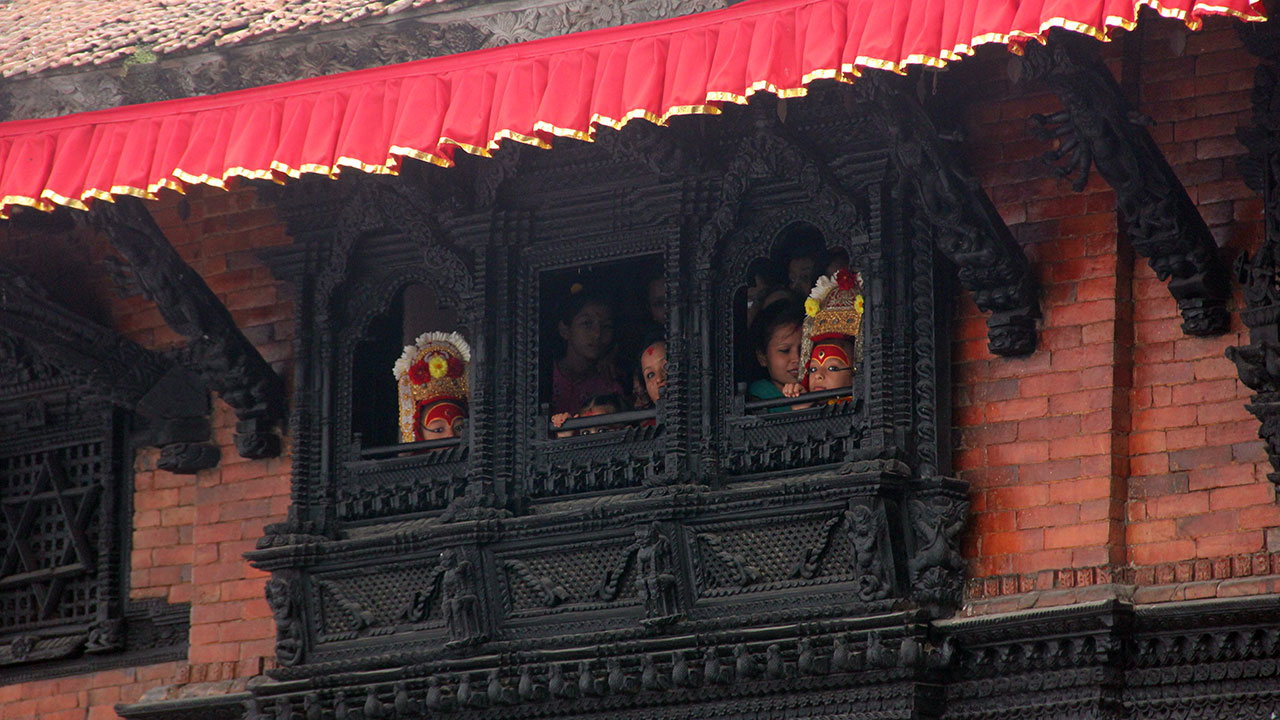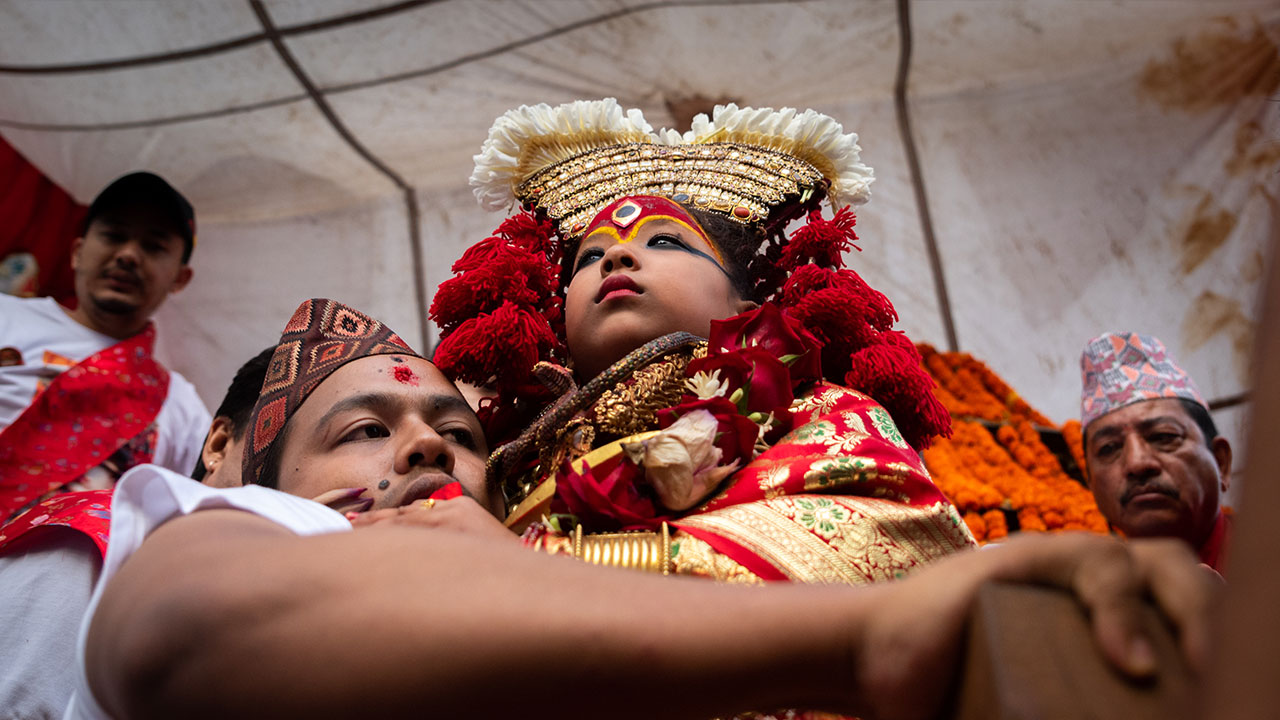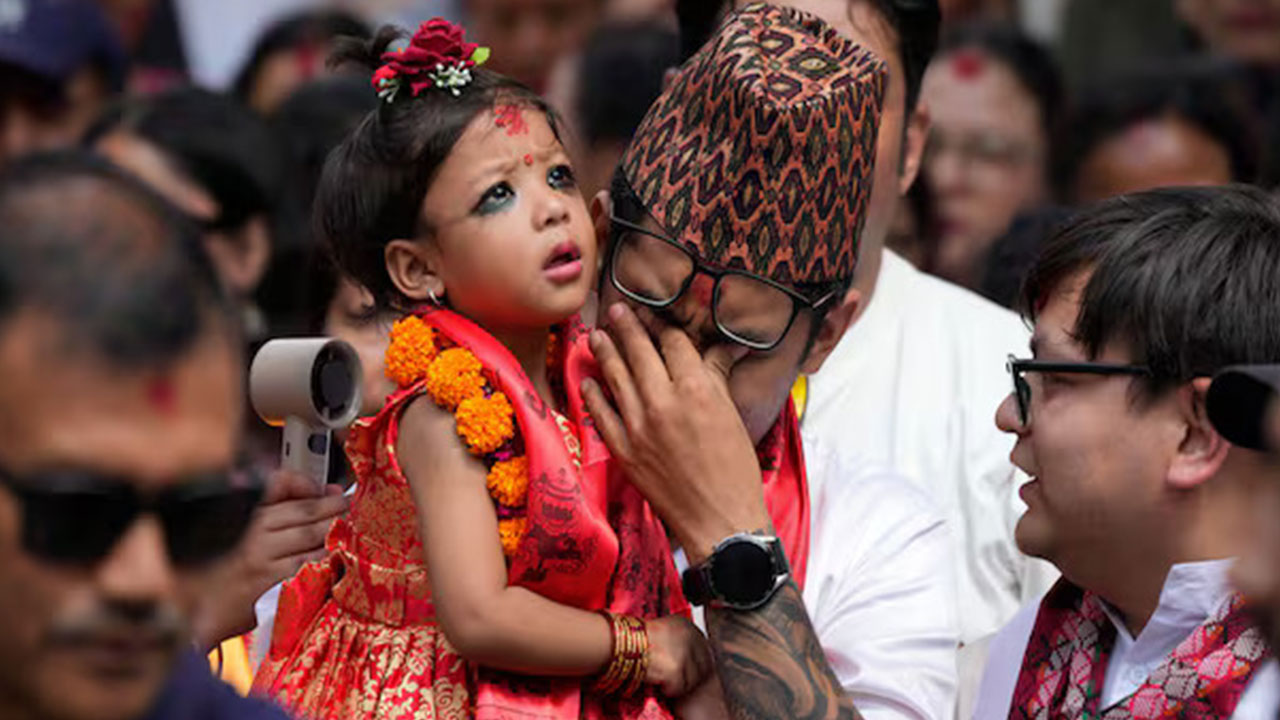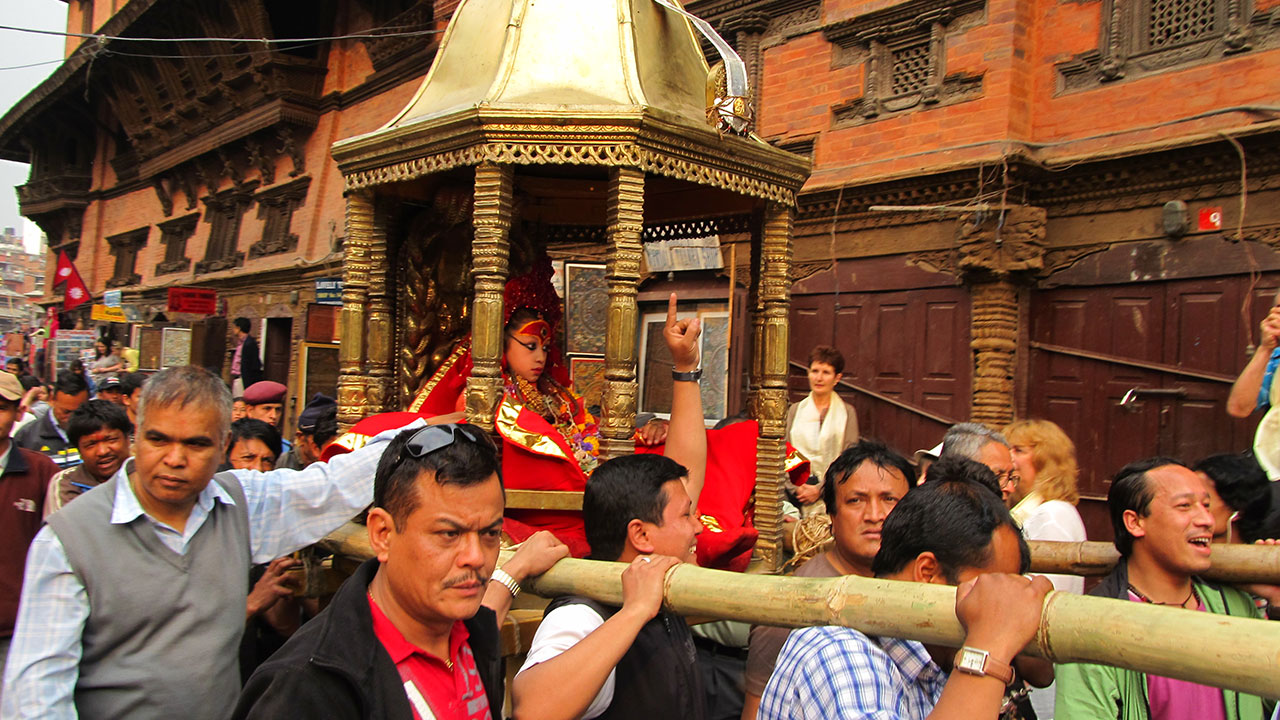In the heart of Kathmandu’s old city, a small child lives a life unlike any other in the mortal realm. She is known as the Kumari Living Goddess of Nepal, a young girl revered as the human form of a powerful Hindu goddess. While most children her age are busy playing in courtyards or learning their first words, the Kumari spends her days inside the historic Kumari Ghar, a 17th-century palace. And the centuries-old faith and tradition shape every moment of her life.
The Shree Kumari Living Goddess is considered the earthly form of Taleju Bhawani, a guardian deity worshipped by both Hindus and Buddhists. The role of Kumari Living Goddess carries centuries of spiritual significance, rooted in Nepal’s deep connection with the divine. Devotees visit her palace every day, waiting in the courtyard for her brief appearance at the window. Just catching a glimpse of her radiant face is believed to bring blessings, luck, and protection.

The tradition of the Kumari has continued for hundreds of years, blending mythology, religion, and monarchy into a single living symbol of Nepali identity. Behind the sacred rituals, though, there lies a deeply human story of one young girl chosen for divinity, living a life of isolation, reverence, and timeless expectation.
This article explores the history, selection process, traditions, and meaning behind the Kumari. From her first day as the chosen child to her life inside the Kumari Ghar and her eventual return to ordinary life. We will look at how this ancient tradition continues to define one of Nepal’s most extraordinary cultural legacies.
Origin and History of Living Goddess Kumari
The tradition of the Kumari Living Goddess is one of the most fascinating and deeply rooted spiritual practices in Nepal. This tradition is considered a living bridge between mythology, faith and history. Its origin traces back several centuries, to the reign of the Malla kings who use to rule the Kathmandu Valley. King Jaya Prakash Malla of Kathmandu is most closely tied to the legend that gave birth to this divine tradition.
It is believed that Goddess Taleju Bhawani (an incarnation of Goddess Durga) used to visit the Malla king each night in the form of a beautiful woman to advise him on matters of governance and faith. Their meetings were sacred and secret; it was bound by divine trust. But one evening, driven by human weakness, the king’s thoughts faltered and the goddess, feeling disrespected, disappeared in anger.
Then, the king, who was overcome with remorse, begged for forgiveness from the goddess. But Taleju Bhawani didn’t appear in front of the king. Instead, she appeared in a vision, declaring that she would no longer visit him in spiritual form. In the vision, she told King Jaya Prakash Malla that she would manifest herself in a living child, a young virgin girl of the Newar Shakya or Bajracharya caste. And, this girl must be worshipped as the embodiment of her power.

This marked the start of the centuries-old tradition of worshipping the Kumari, the Living Goddess of Nepal. The first royal Kumari was chosen in the 17th century and placed in the royal palace of Kathmandu. This residence later came to be known as the Kumari Ghar. Since then, the practice has continued unbroken, with each new Kumari chosen through an intricate process steeped in both Hindu and Buddhist rituals.
The history of the Living Goddess Kumari also reflects Nepal’s unique religious harmony. While the goddess herself originates from the Hindu religion, the priests involved in her selection and worship are often Newar Buddhists. This blending of two great traditions Hinduism and Buddhism is what makes the Kumari an enduring symbol of spiritual unity in Nepal.
Over the centuries, Nepali monarchs and commoners alike have sought her blessings. It is believed that the Kumari’s gaze can bestow protection, prosperity, and legitimacy. Even today, during important state ceremonies and festivals like Indra Jatra, the Kumari is carried through the streets of Kathmandu in a grand chariot, watched by thousands who come to witness the divine child believed to be the living embodiment of Goddess Taleju herself.
The History of the Living Goddess Kumari is not just a tale of kings and rituals, it is a story of faith that continues to thrive in the heart of a modern nation. Despite changing times, the presence of the Shree Kumari Living Goddess remains a reminder that Nepal’s soul is still tied to its ancient roots
The Sacred Home: Kumari Ghar
The Kumari Ghar Living Goddess is situated at the heart of Kathmandu Durbar Square, surrounded by centuries of royal history and artistry. This elegant three-story brick building is not just an architectural marvel of the Malla period, but it is a living shrine where the divinity coexists with the earthly realms.
Built in 1757 AD by King Jaya Prakash Malla, the Kumari Ghar reflects the artistic mastery of Newar craftsmanship. The residence of the Kumari Living Goddess of Nepal is adorned with intricately carved wooden windows, symbolic deities and protective figures that reflect the cultural richness of the Kathmandu Valley. At this sacred residence, every beam and doorway tells a story of faith, tradition, and devotion. All of which have withstood the tides of time.
Inside these sacred walls lives the Shree Kumari Living Goddess, a young girl chosen to embody the power of Taleju Bhawani. Her residence is both her home and her temple, where she partakes in daily rituals to maintain the sanctity of her divine presence. High priests and caretakers perform regular worship, ensuring that every part of the Kumari Ghar remains spiritually pure.
The Kumari Living Goddess rarely steps outside her residence, except during significant festivals such as Indra Jatra, Kumari Jatra, and Dashain. During these major festivals, she is carried in a chariot procession through the old streets of Kathmandu. Thousands of populace gather on these occasions to catch a glimpse of her. It is believed that even a brief sight of the Kumari Living Goddess’s face can bring good fortune and protection.
For most of the year, devotees visit the Kumari Ghar’s courtyard, waiting for her appearance at the upper window. When the Kumari looks down and briefly reveals herself, the atmosphere turns reverent and still. People bow their heads, whisper prayers, and believe that her gaze brings divine blessings.
The Kumari Ghar Living Goddess thus remains one of Nepal’s most sacred places. It is a sanctuary that keeps an ancient faith alive in the modern age. This sacred residence of the Living Goddess is more than a physical structure; it’s a living embodiment of Nepal’s spiritual identity.
How is a Kumari Goddess Chosen?
Kumari Living Goddess Smiling Meaning
It is believed that every expression of the Kumari Living Goddess carries meaning. Even the smallest smile or tear is believed to reveal the will of the divine. Since the Shree Kumari is considered the living embodiment of Taleju Bhawani, her emotions are not seen as human reactions, but as spiritual messages. Thus, they are interpreted by devotees with profound reverence.
When the Kumari smiles, it is considered one of the most auspicious signs. Devotees believe her smile symbolizes divine approval and blessings, a sign that the goddess is pleased. A gentle smile during her public appearance or while blessing someone is said to bring prosperity, harmony, and protection from misfortune. Many believe that a smiling Kumari indicates good fortune for the city and for those who come before her.

But just as her smile brings hope, her crying or frowning holds serious meaning as well. Traditionally, it is believed that tears from the Kumari suggest an omen of sadness, loss, or approaching difficulties. Such a reaction from the Kumari Living Goddess of Nepal is believed to signal natural disasters, political instability, or misfortune in the kingdom.
Even a small frown or sudden expression of discomfort is taken as a warning, as her emotions are seen as reflections of the goddess’s awareness of the world around her. Because of this, the Kumari’s expressions are watched with quiet intensity. Devotees stand in her presence not just to see her, but to read the message she silently conveys.
Life After Divinity: What Happens When the Kumari Retires?
The life of the Kumari Living Goddess is extraordinary, but it is also temporary. Her divine reign ends when she experiences her first menstruation, or in rare cases, when she sheds blood through an accidental injury. Any shedding of blood is seen as the goddess’s departure from her body. And the young girl, once worshipped as divine, returns to normal life.
After her retirement, the former Kumari goes through a series of purification rituals, symbolizing the transition from divinity back to earthly existence. She leaves the Kumari Ghar and rejoins her family. This takes place after years of isolation from normal childhood routines. For the first time in years, she can walk freely in the streets, visit friends, and live as an ordinary girl.
Adjusting to life after divinity can be emotionally complex. Having lived a life surrounded by rituals, caretakers, and reverence, re-entering the world can feel overwhelming. She must adapt to attending school, making friends, and speaking freely. Some former Kumaris describe the transition as liberating yet confusing, as they have to navigate the world that once revered them.
Despite these challenges, former Kumaris are treated with lifelong respect. Many are invited to cultural and religious events. Even in life after retiring as Kumari Living Goddess they are seen as blessed individuals who once carried the goddess within them. There is also a traditional belief that marrying a former Kumari can bring misfortune, a superstition that persists in some circles. Although many modern Nepali people now view it as outdated and unfair.
In recent years, society has become more mindful of supporting former Kumaris through education, counseling, and community reintegration, ensuring they can continue their lives with dignity and opportunity. The journey of a Kumari Living Goddess does not end when she steps down from her throne; it simply transforms.
Though her divine chapter closes, her presence continues to inspire devotion and wonder. It is believed that even when a goddess returns to mortal life, the spirit of Taleju Bhawani still endures within her.
Festivals and Public Appearances
While the Kumari Living Goddess lives a mostly secluded life inside the sacred Kumari Ghar, she makes her public appearance during special events. These rare appearances are among the most spiritually charged celebrations in Nepal, where thousands gather to witness the Kumari Living Goddess.
The most important of these is the Indra Jatra festival, held every September in Kathmandu. During this grand celebration, the Kumari is carried on a beautifully decorated chariot (rath) through the streets of Basantapur, accompanied by the rhythmic traditional Newari music. During this festival, devotees line the streets and throw flowers, hoping to catch a glimpse of Kumari’s divine face. It is believed that receiving her gaze or darshan during Indra Jatra brings blessings, prosperity, and protection from misfortune.

Apart from Indra Jatra, the Kumari also makes appearances during Dashain, Kumari Puja, and special state ceremonies. In these events, she blesses the head of state or government officials, symbolizing that her divine power continues to guide the nation. Even today, before a new king or prime minister takes office, it’s customary to seek the Kumari’s blessing.
During these colorful festivals, the Kumari is carried in her chariot because her feet are considered sacred and cannot touch the ground. The atmosphere feels both sacred and electrifying, as they blend faith, culture, and deep devotion in the heart of the Kathmandu Valley. These public appearances remind the Nepali people that the Kumari is not just a goddess within temple walls but a living link between the divine and the human world.
Who is New Kumari of Nepal?
In October 2025, Nepal welcomed its newest Shree Kumari Living Goddess, Aryatara Shakya, a two-year and eight-month-old girl from the Shakya clan of the Newar community in Kathmandu. She was chosen to succeed the former Royal Kumari, Trishna Shakya, now aged 11, who served as the Living Goddess since 2017 and retired upon reaching puberty.
The selecton of Aryatara Shakya followed the age-old traditions of the Kumari system, where priests and astrologers from the Taleju Temple carefully examine young girls between the ages of 2 and 4 for divine signs. Aryatara was believed to possess the sacred qualities of purity, fearlessness, and auspicious features that marked the true embodiment of Taleju Bhawani.
Her appointment took place during the Dashain festival, one of Nepal’s most important celebrations in Nepal that, which symbolizes the victory of good over evil. Carried in her father’s arms, Aryatara was paraded through the bustling alleys of Kathmandu as devotees lined the streets to touch her feet and seek blessings. The ceremony culminated at the Kumari Ghar in Basantapur Durbar Square, her new sacred residence where she will live until she reaches maturity.

Her father, Ananta Shakya, shared that even before her birth, there were signs of divine destiny. He revealed that his wife had dreamt of a goddess during pregnancy, a vision that the family later saw as a divine indication of Aryatara’s future role.
“My wife during pregnancy dreamed that she was a goddess and we knew she was going to be someone very special,”
Like her predecessors, Aryatara Shakya now lives a secluded but revered life, appearing before the public only during major festivals such as Indra Jatra, Dashain, and Tihar. Inside the Kumari Ghar, the new Kumari Living Goddess of Nepal receives private education and enjoys limited modern comforts, a reflection of evolving traditions that blend spirituality with the realities of modern Nepal.
The government now provides retired Kumaris with a small monthly pension and ensures better education for reigning ones. Still, the role remains deeply spiritual, a living connection between the mortal and divine, cherished by both Hindus and Buddhists alike. Aryatara’s serene presence now represents the continuing legacy of Nepal’s Living Goddess tradition, a timeless embodiment of divine purity that has endured for centuries in the heart of Kathmandu.

